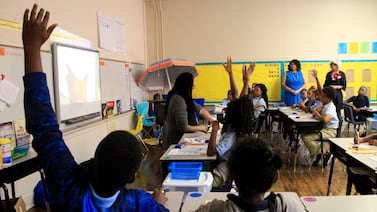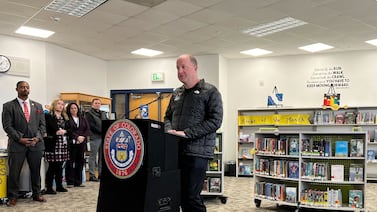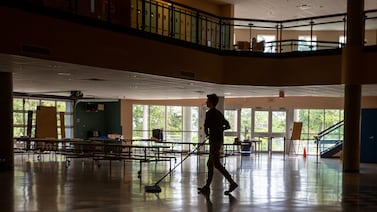Sign up for Chalkbeat New York’s free daily newsletter to get essential news about NYC’s public schools delivered to your inbox.
How do New York City students, parents, and teachers really feel about the nation’s largest school system?
Earlier this week, Chancellor Melissa Aviles-Ramos gave her “State of Our Schools” address, painting a rosy picture of her approval ratings from principals. More than 90% of school leaders who responded to a principal survey last year said they trusted the chancellor, she said.
But that’s in contrast to how teachers feel: More than a third of those who responded to last year’s annual school said they did not trust the chancellor at her word.
Survey results from more than 885,000 teachers, parents, and students in grades 6-12 offer a glimpse of what the 2024-25 school year was like, revealing teachers of the city’s youngest students were the happiest professionally, almost 80% of students reported feeling bored in classrooms, and while not all teachers gave the chancellor glowing reviews, more educators have been happier with her performance than her predecessor’s.
Teachers’ satisfaction with the chancellor improves
More New York City teachers reported feeling satisfied with Aviles-Ramos than David Banks, who abruptly retired about a year ago as federal inquiries swirled around the Adams administration, touching Banks and his brothers. (Banks has not been charged with any wrongdoing.)
Over two-thirds of teachers who responded to the survey said the current chancellor was an effective manager, in comparison to last year, where only 57% thought Banks ran public schools efficiently.
Aviles-Ramos, a career educator from the Bronx, has largely continued the policies started by Banks, including major curriculum overhauls for reading and math. She has also pushed to enlist more parents and students in tackling such issues as chronic absenteeism, vaping, and bullying.
With Mayor Eric Adams dropping out of the race Sunday, it could mean the school system will see a new chancellor midyear. Some education observers have suggested that keeping Aviles-Ramos in her role through the end of the school year could help ease the transition, but new mayors typically select their own chancellor.
“In a system like New York’s, you are who you appoint,” Jonathan Collins, a professor of political science and education at Columbia University Teachers College, previously told Chalkbeat.
Early education teachers share more positive feedback than any other teacher group
Roughly 67,000 teachers took last year’s surveys, and their levels of satisfaction varied based on the grades they taught. For instance, almost 90% of early childhood teachers reported DOE places the needs of children ahead of personal interest. Only 73% of high school teachers believed the same.
Even in their responses about the chancellor, early childhood teachers reported the most positive feelings. About a fifth of early childhood teachers didn’t trust the chancellor compared to about a third of both elementary and middle school teachers. High school teachers had the least favorable responses, with 37% not trusting the chancellor’s word.
For the majority of survey questions, high school teachers responded being less satisfied than early childhood educators.
High school and early education teachers deal with different sets of rules and responsibilities. For example, early education teachers do not test their students and have no more than 20 students in a class.
Some policies could potentially affect working conditions particularly for high school teachers, including a statewide cellphone ban and a class size law limiting high school classrooms to 25 students down from 34 (There are exceptions for physical education and performing groups where the cap is up to 40 students.) For the 2024-25 academic year, just under half of classrooms complied with the law. This school year, 60% of classrooms are supposed to meet the caps, which include 20 students for elementary school classes.
Inside the classroom: fewer students respond to challenging work, teachers vary on improving classroom experience
Since 2023, a little over half of teachers reported that many or all students responded to challenging questions in class. This was a drop from 2022 and pre-pandemic years, where over 60% of all teachers noted students responded to difficult questions in the classroom.
Meanwhile 39% of all students said some classes were challenging while just under a tenth said none were, a roughly consistent response since 2021. And 78% of students last year said they felt bored in school.
After the pandemic, many teachers said they saw a shift in how some students approached their schoolwork. Teachers noticed lower stamina, more distractions with cellphones, and sometimes a feeling that kids didn’t feel like they needed to show up. Chronic absenteeism rates remain relatively high, with 1 in 3 students missing at least 10% of class last school year.
Teachers slightly varied on whether they were successful at improving student learning and schools in general. Less than 70% of high school teachers said their colleagues are eager to try new ideas compared to more than 80% of early education teachers. Similiarly elementary and early education teachers overwhelmingly said teachers feel responsible that students learn. But numbers dipped for middle and high school teachers, where 86% and 82% agreed, respectively.
Nonbinary students are struggling socially
Nonbinary students struggled the most with wellbeing, bullying, and feeling included in classrooms.
Just 94 of last year’s roughly 350,000 students in grades 6-12 who filled out the survey identified as nonbinary. (The number of nonbinary students may be an undercount since changing a student’s gender on paper requires parental consent and can take a long time to process. Similarly, caregivers may not know if they can request to change a student’s gender on paper, Chalkbeat previously reported.)
Results show over 70% of nonbinary students felt stressed, and more than half reported they worry at schools. Similarly, less than half felt their schools supported their social and emotional well-being. Since 2023, parents of nonbinary students have consistently had the lowest score for trusting principals and believing conflicts were properly resolved at their child’s schools.
“We are not surprised that the NYC Public Schools Survey shows that nonbinary students disproportionately report feeling less safe in schools and are overall experiencing more difficulty,” said Peter Karys, a social worker and director of Youth Counseling & Support at The NYC LGBT Community Center. Karys said many schools still lack the resources to support transgender and nonbinary students.
“The isolation transgender and nonbinary students face in school makes them more likely to turn to substance use — which exacerbates social and emotional issues,” he added.
The Trump administration eliminated $15 million in grant funding last week after the city refused to remove policies that protect both transgender and nonbinary students.
Ananya Chetia is a reporting intern for Chalkbeat New York, covering NYC public schools. Contact Ananya at achetia@chalkbeat.org.





